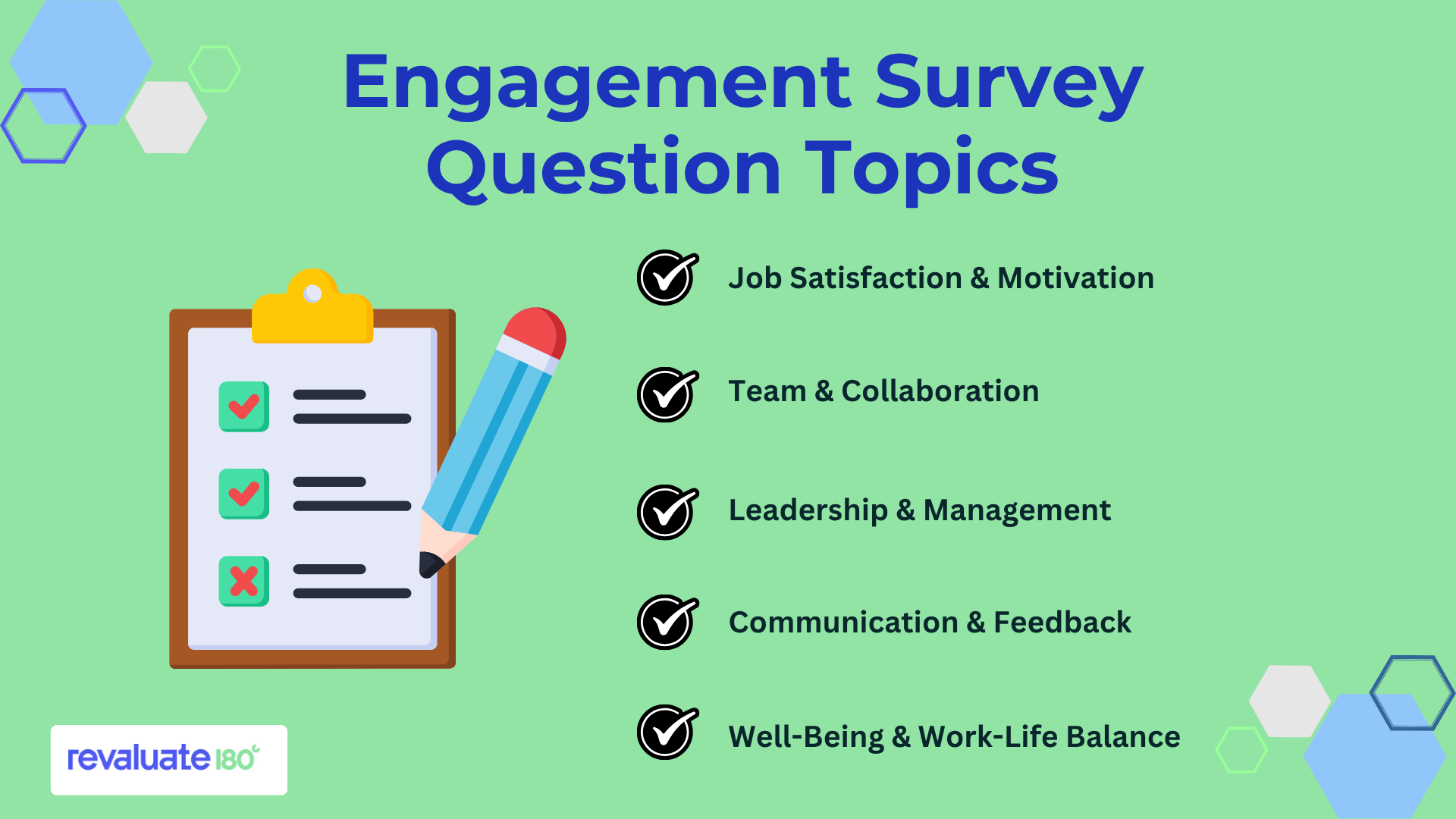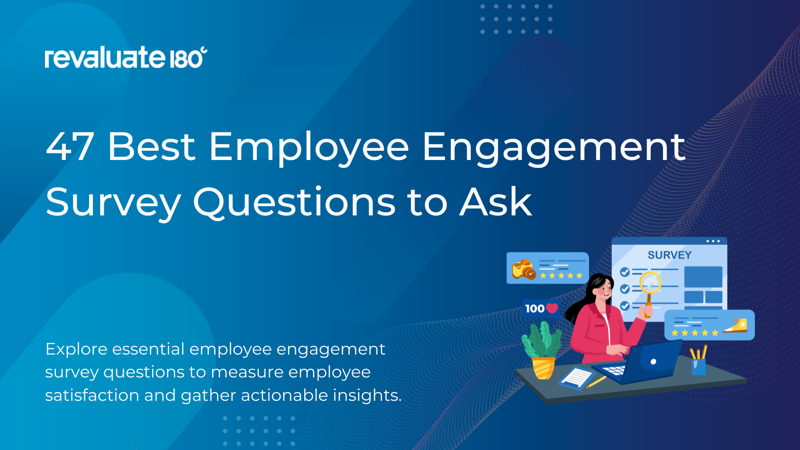Employee engagement initiatives are highly critical in all kinds of workplaces to ensure employees remain motivated, satisfied, and happy at work. These days, employees look for a positive, empathetic, and supportive work environment, rather than just pay packages and other monetary benefits.
However, measuring employee satisfaction levels and understanding how to help employees engage better at the workplace can be challenging for many companies. This is where employee engagement surveys help companies measure engagement levels and come up with the right initiatives to boost their employees' productivity.
Asking the right questions helps gather accurate insights to measure employee satisfaction levels, which in turn enables company leaders and HR professionals to optimize their policies and initiatives for the benefit of employees.
In this post, we have compiled some of the most frequently asked employee engagement survey questions, which can be helpful during both quick pulse surveys and comprehensive annual surveys.
TL;DR
- Employee engagement surveys help companies understand employees’ satisfaction with various aspects of the company’s functioning, including their workload, leadership, career growth opportunities, and team culture.
- Surveys must comprise a balanced set of score-based and open-ended questions.
- This guide provides a list of helpful employee engagement survey questions organized into various categories that companies can use during their pulse surveys or annual surveys.
- Discover how Revaluate180 helps transform your survey data into actionable insights and engagement strategies, enhancing your company’s performance and retention.
What is an Employee Engagement Survey?
Employee engagement surveys are the best tools for measuring how committed and satisfied employees are with their work and their workplace, as the work environment plays a significant role in their productivity. Actively engaged employees contribute the best while also spreading their enthusiasm to other team members and peers at work.
Since there are no specific metrics to measure engagement levels and derive insights into employee engagement, periodic engagement surveys help companies gather employee feedback regarding their satisfaction with the company.
These surveys offer several benefits for companies in understanding employees’ needs and expectations. Running such surveys involves following certain necessary steps and processes to ensure that employees provide accurate data, which will, in turn, benefit them.
Why Asking the Right Questions is Important
Employee engagement surveys must not be treated like namesake feedback surveys. The data collected from these surveys has the power to change the fate of a company’s future, saving the employees from making extreme decisions and preventing losses for the company.
Here are some of the reasons why a good mix of survey questions is crucial in all types of engagement surveys:
- Collect accurate feedback: The right questions and corresponding answers help companies identify the exact areas that concern employees, enabling them to work to their fullest potential.
- Make informed decisions: Insights from engagement surveys form the basis for driving company leaders to make data-driven decisions, aligning expectations with reality.
- Identify neutral and disengaged employees: Monitoring employee survey responses helps identify those who provide neutral or negative feedback scores. Such employees must be handled more effectively by their managers and teams to understand the reasons behind their disengagement.
- Scope for improvement: Low scores from most employees on any aspect of a company’s functioning help identify areas where companies can refine relevant policies or develop better initiatives to improve employee satisfaction.
What Are the Different Types of Employee Engagement Surveys
Depending on the number of employees taking the survey and its frequency, surveys can be either short or long and in-depth, allowing for the gathering of employees' feedback. Here are some of the common types of surveys, where questions may or may not occur repeatedly.
1. Annual or Comprehensive Surveys
These are detailed surveys where employees give their insights on several dimensions of their workplace. Each section has a good mix of questions, ranging from open-ended questions to scoring-based questions. As the name says, comprehensive surveys are conducted once or at most twice a year to gather detailed information on employee concerns.
2. Pulse Surveys
These are brief and concise surveys, typically focusing on one or more workplace factors, such as team dynamics, career growth, company processes, and others. Such surveys often have questions that let employees rate performances and quality using the Likert scale, scoring on a scale, emoticon scoring, and more. Pulse surveys can be conducted as and when a company finds a purpose to understand employee engagement levels at any instance.
3. Onboarding and Exit Surveys
These are surveys conducted during the initial and final phases of an employee’s tenure in the company. Such surveys aim to understand and bridge gaps between employee expectations and the company’s current initiatives to achieve productivity and engagement. Onboarding surveys ensure that new employees do not reconsider their decision to work for the company, while exit surveys help identify problem areas that can be corrected to prevent further turnover.
4. Lifecycle or Check-in Surveys
Check-in surveys are similar to pulse surveys, with questions generally aimed at employees' well-being and satisfaction with any current issues. For instance, the yearly appraisal sessions are often followed up with appraisal surveys to gauge employees' perceptions of their evaluations. Such surveys help companies understand any employee dissatisfaction and enable them to prevent sudden turnover.
47 Employee Engagement Survey Questions to Ask on Your Next Survey

Employee engagement surveys consist of different categories that directly influence an employee’s commitment to their work. Here, we have compiled a set of common survey questions that you can ask under each category. You can use one or more categories of these questions in any of your pulse surveys or annual surveys.
You can also download the PDF containing a checklist of employee engagement survey questions for easy reference.
Questions About Job Satisfaction and Motivation
This category is a mandatory part of every employee engagement survey. Questions relating to job satisfaction aim to understand employees’ pulse regularly and further probe to discover any underlying concerns. Scoring and rating-based questions are best to gain an overall view of employees’ satisfaction levels, ranging from highly satisfied to highly dissatisfied scores.
- “I feel motivated to do my best work every day.”
- “My role provides purpose for my skills and strengths.”
- “I find my work meaningful and worthy.”
- “I get abundant career growth opportunities right here.”
- “I have referred/will refer my peers for roles in the company.”

Unlock AI-Powered Hiring Analytics
Transform the way you hire with insights that create aligned, collaborative, and high-performing teams.
 Smarter Hiring Decisions
Smarter Hiring Decisions
 Reduce Expensive Turnover
Reduce Expensive Turnover
 AI-Driven Insights
AI-Driven Insights
 Optimize Team Performance
Optimize Team Performance

Questions About Team and Collaboration
Employees’ teams play a significant role in influencing their commitment to work and attitude to remain productive. Trust issues, miscommunication, poor conflict resolution, and mismatched skill-role assignment often cause the entire team to feel disengaged and affect their work. Here are some questions that employees must answer regularly to assess the quality of their teams.
- “My team members communicate openly and effectively.”
- “I can rely on my colleagues when I need help.”
- “Our team shares a common purpose.”
- “My team comprises members who collectively embrace strengths.”
- “Conflict resolutions are settled amicably in our team without external intervention.”
- “I can reach out to peers in my team for any assistance and technical aid.”
Questions About Leadership and Management
Leaders have the potential to keep their employees actively engaged by smoothly resolving conflicts and providing amicable solutions. Employees feel comfortable when their leaders are approachable without any biases or preconceived notions. Therefore, it is essential to have questions about leaders and their ability to implement initiatives for employee benefits.
- “My manager recognizes my contributions.”
- “Our group leaders communicate company goals clearly.”
- “I trust our leaders to make fair and transparent decisions.”
- “Our company leaders see themselves in our shoes to lead us in the right direction.”
- “Our management provides equal benefits and perks to all employees.”
Questions About Company Culture and Belonging
A small yet highly significant factor that determines an employee's longevity in a company is the amount of belongingness that employees feel while working there. Inclusion and belonging are among the most complex parameters to measure, thus necessitating a well-balanced mix of survey questions that help gauge how employees feel welcome and valued at work. A sense of belonging stems from an adaptive and positive company culture where employees embrace unity in diversity.
- “I feel a sense of belonging at work.”
- “Our organization values diverse perspectives, providing fair opportunities.”
- “Diverse employment in our company goes beyond just filling representational quotas.”
- “I am proud to work for this company.”
- “My peers outside the company wish they worked in a company like ours.”
- “My company abides by labor laws, while keeping in mind employee benefits like flexibility.”
Questions About Communication and Feedback
Employees exhibit high levels of engagement when companies adopt different internal communication strategies to keep employees feeling included in the company. Efficient communication strategies, along with sufficient channels for employees to provide feedback, should be regularly reviewed through employee engagement surveys to ensure a top-notch experience for employees.
- “I receive important information in a timely manner.”
- “My feedback is valued and acted upon.”
- “I know where to share suggestions or concerns.”
- “I am regularly updated with information relating to policies and initiatives.”
- “My team members have open discussions relating to any topic about the company.”
- “Our company has a robust internal communications team to keep us up-to-date with the latest happenings.”
Questions About Well-Being and Work-Life Balance
Flexibility in balancing work and personal life appears to be the most significant driver of employee engagement and retention. Employee wellness initiatives and work-life balance are now the top sought-after parameters that employees look for when joining a company, surpassing their paychecks. Therefore, companies should monitor employee wellness levels through periodic pulse surveys.
- “I can maintain a healthy balance between work and personal life.”
- “My workload feels manageable.”
- “The organization supports my mental health.”
- “My team backs me up during emergencies.”
- “My manager encourages me to unwind and stop getting burned out.”
- “My company has been a pioneer in bringing flexible work initiatives to suit employee needs.”
Open-Ended Questions for Deeper Insights
Apart from scoring-based questions, every engagement survey must have one or more open-ended questions. Such questions help employees put their concerns using the exact terms that they have in mind. Moreover, such questions encourage employees to communicate using their familiar vocabulary, providing greater clarity on any concerns they may have.
- “What’s one thing we should start doing to improve employee engagement?”
- “What’s one thing you would change about your work environment?”
- “What makes you proud to work here?”
- “How would you describe your journey since you joined our company?”
- “What do you feel are the positives and negatives of our company’s culture?”
- “How have you handled any burnout situations at work?”
- “Where would you prefer working if not in our company, and why?”
Follow-up Questions to Assess Survey Impact
An employee engagement survey remains successful only if the survey results are analyzed, acted upon, and communicated through official channels to all the participants. This communication must be followed by a feedback survey where employees share their satisfaction with the survey and its impact.
- “My manager discussed results from the last survey with our team.”
- “I’ve noticed positive changes since our last engagement survey.”
- “Our survey responses are highly valued for impactful changes.”
- “We get detailed survey reports/results from our manager or internal communications.”
- “The survey questionnaire values our time and is convenient to respond to.”
- “Our surveys are conveniently spaced for the management to implement sufficient actions.”
Mistakes to Avoid When Writing Employee Engagement Questions
The employee engagement survey questions that we have discussed above under several categories are just a sample of how one can understand employee satisfaction levels. You can alter or add more questions that are specific to your survey’s intent.
Keep these pointers in mind while selecting or crafting questions for your engagement surveys.
-
Avoid Leading or Biased Questions: Questions should not appear forceful or force employees to agree or disagree. Do not ask questions that go like:
“Don’t you agree that….”“Isn’t it possible for…”Such questions force employees to align their answers in an unfair or biased manner.
-
Double-Barreled or Overly Complex Questions: Adding two or more clauses in a single question can confuse employees, as they may agree with one clause but disagree with another. Questions like:
“My manager communicates well and resolves conflicts” should be asked as two separate questions, as a good communicator does not necessarily communicate in the same way when resolving conflicts. - Overly Broad or Vague Phrasing: The vocabulary used while framing questions must be generic and understandable by all participants taking the survey. If using terms specific to your company's policies or initiatives, ensure you provide the correct definitions before employees begin the survey.
- Ignoring Follow-Up or Feedback Loops: Every survey must include questions to measure whether past survey questions have had an impact and brought about any change. Follow-ups to previously raised concerns are necessary to ensure employees who were disengaged or unsatisfied are now happy with the new changes.
- Not Acting on Survey Results: Conducting surveys solely for the purpose of promoting engagement and failing to respond to the results creates a negative impression of the company’s management. Non-response to surveys from the company makes employees feel that their opinions are not valued. Naturally, they stop giving accurate survey responses or even skip taking engagement surveys.
How Revaluate180 Helps You Build Data-Driven Engagement Strategies
Apart from conducting employee engagement surveys with the right questions, you must also invest time and effort to derive meaningful insights from the survey results. However, interpreting survey results and tracking their efficiency over time can be overwhelming without the analytics and expertise.
Revaluate180 is a data-driven HR consulting service that helps companies consistently improve their engagement initiatives for the benefit of their employees. Our advanced AI analytics, combined with our consulting expertise, help you to interpret engagement data accurately and make informed, actionable decisions.
Our bespoke solutions help businesses monitor changes in employee engagement at every stage of the employee lifecycle. We also assist in designing effective engagement surveys that reveal what truly drives your team. These insights enable organizations to design effective team-building initiatives that enhance performance and overall productivity.
FAQs
1. How many questions should an employee engagement survey have?
The number of survey questions depends on the amount of time employees must spend to complete them with concrete answers. Ideally, short pulse surveys should have around 10-15 questions, while elaborate annual engagement surveys should not exceed 40 to 45 questions, spanning all possible categories.
2. Should employee engagement surveys be anonymous?
Surveys need not be anonymous. Insights from surveys appear accurate only when the source of concerns is known, allowing those employees to receive better engagement assistance.
However, if surveys contain questions related to sensitive topics, such as sexual harassment, gender-specific concerns, or questions pertaining to relationships with managers, employees can be given the option to provide their answers anonymously.
3. How often should you run employee engagement surveys?
Short or brief engagement surveys can be conducted on a weekly, monthly, quarterly, or yearly basis, or at any other frequency, depending on the criticality of analyzing engagement levels within the company.
Detailed surveys can be conducted once or twice a year for better insights. It is essential to space surveys at sufficient intervals to avoid overburdening your employees with surveys.
4. What is the difference between employee satisfaction and engagement?
Satisfaction surveys are designed to gather feedback on specific programs or initiatives that require minimal action. However, engagement surveys aim to garner overall opinions regarding any initiatives or concerns that employees face. Following such surveys, management and leaders implement company-wide actions that can improve the quality of a company’s work culture.
